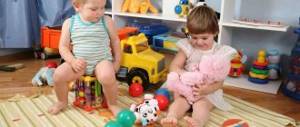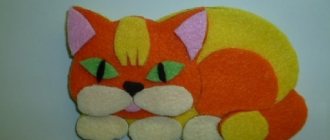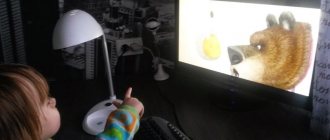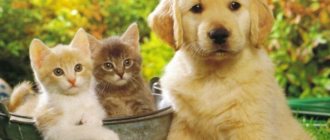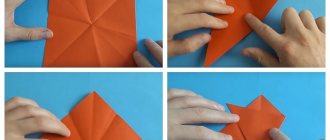6th competition-game “Who gives what voice”.
One participant is the driver. He turns his back to the children. At the teacher’s command, one of the children calls the driver as a pig or a chicken, a cow, etc. might call him. The driver guesses the name of the child who called him and says what kind of pet or bird he was speaking in at that moment. Then another child becomes the driver. The game should not be long, because... children will lose interest in it.
7th competition “Tongue twisters and lullabies”.
Each team receives a tongue twister. Children should learn to pronounce it correctly and as quickly as possible in 1 minute.
Tongue twisters to choose from:
Ram Buyan climbed into the weeds;
Thirty-three striped piglets have thirty-three tails hanging;
Goose Gog and Goose Gaga don't take a step without each other;
Our Polkan fell into a trap.
Q. Guys, remember when you were little, your mothers sang lullabies to you. Who was most often addressed in these songs? (To the cat.) (For example, the teacher reads one of these folk lullabies. And if time and the level of development of the children allows, you can listen to their favorite lullabies prepared by the children at home, the heroes of which are pets (cat, chicken, dog).
8th competition “Curious people, go ahead!”
Q. Guys, I’m sure you and your parents read a lot at home, and you also spend time outside the city. Try to answer these difficult questions:
How do horses sleep? (Horses can sleep standing up - and doze off, and sleep soundly. They received this ability from their wild ancestors. When a horse stands in one place for a long time, its knee joints snap into place, as if it were a lock - this is the structure of their legs. But horses can sleep and lying down. By the way, modern horses increasingly lie down on soft bedding and sleep lying down.)
Question for girls: What kind of work can a horse do?
(Transport passengers, cargo, mail, plow, harrow, participate in horse races, etc.)
Question for boys: In what wars did horses participate? (Horses have participated in all wars, from antiquity to the mid-twentieth century.)
"Pets" GCD in the senior group
Author - compiler:
Antipina Natalya Sergeevna
Educator.
MADO kindergarten No. 1 in Tyumen
Summary of integrated educational activities for children of the senior group
Goal: to systematize children’s knowledge and ideas about domestic animals.
Tasks :
Area Cognitive development
To activate and consolidate children's knowledge about pets, their lifestyle, and the benefits of pets for humans.
Establish the relationship and dependence of animal life on humans. To form the concept of “pets”, interest in pets.
Area Speech development
Develop coherent speech and articulatory apparatus.
Sound culture of speech “sound -sh”.
Encourage attempts to express your point of view and seek complete answers. Continue teaching how to solve riddles.
Area Social and communicative development
Develop communication skills, ability to work and play
a team.
Area Physical development
Develop children's motor activity
Equipment and materials:
Demo: “Farm” layout, “Pets” pictures. Handout: Plasticine, board, stack.
Preliminary work: Conversations, examination of illustrations, video films.
Progress of educational activities.
Educator: Close your eyes and listen to the “Voices of Pets.” (Audio recording sounds) What did you hear? How can you call them in one word? Correct – (Pets). And what are they? kind, helpful, necessary. Today we will go to the village, we were invited to visit.
Guess who this is? Emerald eyes, downy fur coat, kind songs, sharp claws. (Cat)
And the cat Vaska has prepared riddles for you, if we guess them, we will find out who he is friends with.
– He is friends with the owner, guards the house, lives under the porch, tail in a ring (children’s answer)
Educator: Guys, guess the following riddles: Well-fed - chews, hungry - moos, gives milk? Did you find out who it is? (children's answer);
In the autumn he climbed into the cabbage, horned and with a long beard. Who is he? (children's answers)
Instead of a nose there is a snout, on his feet there are hooves.
He eats and drinks from a trough. Who is this? (children’s answer);
Educator: Guys! Now we know who Vasily the Cat’s friends are.
It's winter outside and it's very difficult for the animals. Let's bring some treats for the animals.
Do you know what every animal loves?
Didactic game “Where is whose lunch”
(children choose pictures and attach them to the board).
Educator. Results of the game.
Let's walk part of the way like cats. Relaxation game “Evil and Good Cats” (Bend and inflate the back and say –shh)
Educator: Well, we've gained strength and rested! Now let's play sports! The road to the village is covered in snow, how will we get there? (children's answers)
Educator: I agree with you, you can ski! (Children, imitating movements on skis, approach the “Farm” layout
The cat Vasily is sitting on the fence of the farm. The teacher and the guys say hello and give treats to the animals.
Educator: A few thousand years ago, ancient man took the first steps to domesticate wild animals in order to use them for his own purposes. And today it is difficult to imagine our life without pets, as if they have always been faithful companions of people. Initially, man sought to obtain something valuable from animals, providing them with shelter and food.
Pets are animals that have been tamed by humans by caring for them and providing them with food.
Guys, please tell me what benefits do pets bring to us? (children's answers) Who gives milk? (cow, goat) Who lays eggs? (chicken) What is the cat Vaska useful for? (Catches mice) Who guards the house and garden? (dog) Horse? (carries various weights) And from whose wool can you knit socks, mittens, blouses? (sheep, goat, dog). Educator. Guys, do you know where the animals will spend the winter, what the buildings are called? (Cow barn, barn, booth, kennel, corral)
Interesting! Alternative medicine has long noted the ability of animals to heal people. Cats achieve the greatest success in this. Scientists explain the effectiveness of cat therapy by the ability of this animal to create a unique electromagnetic field with low-frequency currents thanks to its thin and soft fur. This allows the cat to act on the source of inflammation and pain and destroy microbes.
Scientists have proven that stroking an animal is not only pleasant, but also useful. Your mood improves.
Pets are roughly divided into two groups.
- The first includes agricultural species used in everyday life and making it possible to obtain natural products and materials. For example, goats and cows provide human food: milk and meat, as well as wool and leather. But horses, despite the emergence of various mechanisms, are still used as labor for transporting goods and as a means of transportation.
- The second group unites all the animals that people keep primarily for communication and leisure. Cats, fish, rodents and dogs are just some of the pets living at home. Such pets, first of all, become full-fledged family members and a person’s friend. They help cope with bad moods, combat loneliness and stress.
A dog has become man's most devoted friend living at home. There is an opinion that, unlike cats, it is more strongly attached to humans.
When deciding to get a dog, you should also know that it needs constant care. Regular walks and feeding are only a small part of care. It is important to immediately decide on the breed, because each has its own characteristics. The character of the animal and what kind of care will be required depend on them.
Guys, Vaska the cat is crying! Why? His dog friend Sharik’s kennel has broken down and he’s sleeping outside in the cold snow! Let's help Sharik! And we'll make him a booth out of plasticine!
Well done! Now Sharik and his friends - stray dogs - will have a place to spend the winter in the cold winter!
And Vaska the Cat wants to play with you! Finger gymnastics “I want to build a house”
I want to build a house so that there is a window in it, so that the house has a door nearby, so that a pine tree grows, so that there is a fence around it, and a dog guards the gate. IN
ICQ says to the children “Thank you”, “Goodbye” Children say goodbye to the animals. Educator: Well, it’s time for us to return to kindergarten. Where are our skis? Let's put it on and go! Educator. Here we are in kindergarten!
where were we? Who did you see? How can you call them in one word? (pets) And they help us a lot! Useful and important!
List of sources used:
1.N.E.Veraxy, T.S. Komarova, M.A. Vasilyeva “Approximate general educational program for preschool education” 3rd edition, revised; Mosaic-Synthesis, Moscow, 2014. 2. M.A. Vasilyeva “Comprehensive lessons according to the program.”
3. L.A. Paramonova “Developmental activities with children”
4.Finger games from the index of finger games.,
5. A.V. Zaporozhets and A.P. Usova – “Game and child development, Psychology, pedagogy of preschooler play”
https://animalsik.com/domashnie-zhivotnyie
https://det-1446-127322.narod.ru/doc.31.html
“Certificate of publication in the media” Series A No. 0004507
We invite teachers of preschool education in the Tyumen region, Yamal-Nenets Autonomous Okrug and Khanty-Mansi Autonomous Okrug-Yugra to publish their teaching materials: - Pedagogical experience, original programs, teaching aids, presentations for classes, electronic games; — Personally developed notes and scenarios of educational activities, projects, master classes (including videos), forms of work with families and teachers.
Why is it profitable to publish with us?
1. 1. “Kindergartens of the Tyumen Region” is an officially registered specialized media outlet at the federal level. 2. The activities of the editorial office are supported by the Department of Education and Science of the Tyumen Region 3. We issue a “Certificate of Publication” in the media. 4. The document has a unique number, is entered in the register, has the original seal of the editorial office of the online publication and signature. 5. “Certificate of publication” in the media is sent to the author in both paper and electronic versions. In detail In detail >>> Sample “Certificate of publication of author’s methodological material in the media”.pdf
Share
Samples of drawings on the topic “Wild and Domestic Animals” with comments on the completion of the work
Photo gallery “Wild Animals”
Preschoolers love to draw giraffes - the bright appearance of this beautiful animal lifts their spirits and seems to transport them to hot and sunny Africa. The graceful animal is presented in the work “Handsome Giraffe”. The “Family of Giraffes” looks touching, with males and females slightly different in skin color and size. Funny animals are depicted in the drawings “Beautiful Giraffe” and “Giraffe”.
The kids also like to experiment with the theme of polar bears. The composition “Northern Bears”, made on a light blue background, looks gentle. Cute bear cubs are presented at the Umka photo exhibition. The wonderful work “Bears and the Northern Lights” is original, depicting, in addition to animals, a most beautiful natural phenomenon.
Spiny hedgehogs are traditionally drawn using the poking method (“Hedgehog in the Forest” and the photo exhibition “Hedgehog”).
An interesting squirrel is depicted in the drawing “Beauty Squirrel” - she seems to be bouncing on a tree branch. Her luxurious tail and light coloring of her abdomen are realistically conveyed.
The composition “Amur Tiger in the Taiga” is impressive: not only is the image of this beautiful animal drawn in detail, but also the grass is realistically depicted.
A preschooler depicted a touching story in the drawing “Caring Mom”: a bear catches a fish for her little cubs. The work is done in soft pastel colors.
We see a neat red beauty in the drawing “Fox”; the animal is depicted in pencil against a background of watercolor greenery. We also see an interpretation of the fox theme in the work “Fox Hunting in Winter.” In addition to the fox, there is also a white bunny depicted here. Let us note the very beautiful landscape background of this picture.
An interesting plot composition is “The Bear and the Bees,” in which a clumsy bear climbs a tree to get to a hive with delicious honey. And the bees, apparently, are going to attack him. And although the insects are drawn somewhat bulkily compared to the bear, the drawing is done very well. Note that the composition was created based on an outdoor game familiar to preschoolers - “The Bear and the Bees.”
Another work based on the plot of an outdoor game is “The Fox in the Chicken Coop.”
Watercolor drawing Watercolor drawing
Watercolor drawing
Watercolor drawing
Watercolor drawing
Drawing with a poke Drawing with a palm
Watercolor drawing
Pencil drawing
Watercolor drawing Watercolor drawing
Watercolor drawing
Watercolor drawing
Watercolor drawing Drawing with the inclusion of an unconventional poking technique
Poking drawing
Motivating start to class
Drawing an animal figure in a characteristic pose or movement is a complex visual activity for preschool children. Creating a preliminary contour drawing from geometric shapes can be boring, practicing brush drawing techniques can be monotonous. To prevent children from losing interest in drawing, the teacher needs to use motivating material during the lesson.
Examples of using motivational material
| Type of motivating material | Examples of a motivating start to a lesson |
| Visual material: pictures and posters with images of animals, toys and figurines, slides, illustrations in books. | "Two greedy little bears." Pictures with illustrations of the fairy tale are attached to the magnetic board or the pictures are projected onto the screen. The children are invited to study the illustrations and arrange them in the order in which these scenes in the fairy tale are described. A conversation must be held based on the visual material: What animals are shown in the pictures? What features of the image of bear cubs and foxes did the guys notice? What colors and drawing techniques did the illustrator use? Which episode is shown most successfully and vividly, according to the students? |
| Reading poems, excerpts from fairy tales, nursery rhymes, riddles, proverbs. | "White bears". At the beginning of the lesson, the teacher asks the children an animal: Among the snow and ice it does not go hungry, it dives into cold water for fish, its thick white fur saves it, it warms it from frost. (Polar bear) The children are asked to remember what structural features of the polar bear’s body are, and then the teacher reads passages describing this animal from the Yukaghir fairy tales “Why does the polar bear have a black nose?”, “Who lives in the cold sea?” |
| Creating surprise moments and game situations. | "Sheep in the meadow." At the beginning of the lesson, a knock is heard, Kurochka (a junior teacher dressed in a suit) enters the group and tells the children that a Sheep lives in their village - a kind and beautiful animal. Hen describes the fur of a sheep: white, light, soft, in the form of rings and curls. But autumn came and the farmer cut the sheep’s wool so that the housewife could make yarn out of it and knit warm clothes for the winter. The Chicken reports that the Sheep does not feel sorry for the wool for the farm kids, but she is still sad for her beautiful fur coat. The chicken asks the guys for help, they decide that they can draw a sheep in a new fur coat. |
| Conducting a conversation on the topic of the lesson (with reference to the experience and ideas of the students). | "Journey to the Farm" The teacher hangs pictures of domestic animals on the board: cows, horses, rabbits, pigs, goats, sheep. The guys are asked the question: “Where can you see all these animals?” - in a village, village, on a farm. Before the children begin to study and discuss the poster “At the (Horse) Farm,” the teacher invites people to share stories and memories of those who have been on a farm, and also gives the opportunity to speak to those who have seen farms in films or read stories about them. . |
| Conducting physical education lessons, outdoor and didactic games on the topic of the lesson. | "Mustachioed - Striped". Outdoor games “Cat and Kittens”, “Vaska the Cat”. Physical education lessons with performing movements to the poems “Our Murka has kittens”, “All the kittens washed their paws”, etc. Didactic games: “Help the kitten untangle the ball”, “Find the differences in the pictures”, “Which cat does this shadow belong to”. |
Drawing up notes for an art lesson on the topic “Wild and Domestic Animals”
The duration of a drawing lesson for children 5–6 years old is no more than 25 minutes and consists of the following steps:
- Organizational moment 1 minute.
- Motivating start of the lesson 5-6 minutes.
- Discussion of the drawing algorithm 2–3 minutes.
- Practical work 10–11 minutes.
- Demonstration and discussion of drawings 2–3 minutes.
- Summing up 1 minute.
Outline of a drawing lesson (senior group) on the topic “Hedgehog” Author: Natalya Aleksandrovna Ashenkova
| Tasks | Learn to draw conclusions from the discussion during the conversation. Improve your ability to paint with a brush. Develop an interest in drawing. Form aesthetic taste. |
| Material | Illustrations depicting a hedgehog, photographs. Cut out silhouettes of hedgehogs, brushes, paper and paints for painting. Audio recording with forest music. |
| Preliminary work | Reading stories about forest animals, looking at illustrations in books. Learning poems about wild animals. Listening to audio recordings with sounds and voices of nature. Visit to the local history museum to get acquainted with wild animals. |
| Progress of the lesson | The children will learn the topic of the lesson after learning the answer to the riddle about the hedgehog. Listening to N. Charushin’s fairy tale “The Hedgehog”, discussing the content of the text: what features of the appearance of the hedgehog were described by the author. The teacher invites the children to draw a fairy tale hero. Studying the algorithm for drawing a hedgehog. Creating a pencil sketch. Performing a warm-up exercise with a brush. Practical work with paints. Break for the outdoor game “Hedgehog with Hedgehogs.” Children complete the drawings with small details. Demonstration and analysis of finished works. Summing up the lesson. |


